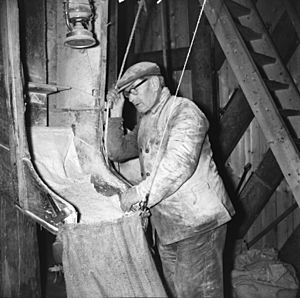Miller facts for kids
A miller is a person who runs a mill. A mill is a machine that grinds cereal crops to make flour. Grinding grain into flour is one of the oldest jobs people have done. The word "Miller" and similar names like "Müller" (German) or "Molenaar" (Dutch) are common last names around the world. This shows how important millers have been throughout history.
Milling began even when people were hunter-gatherers. Millers became even more important as farming developed. Millers usually grind grains and other food items. Grinding food helps us digest its nutrients more easily. It also saves wear on our teeth. Millers can also process non-food items, like building materials, into a fine powder.
Contents
Early Tools: The Quern-stone

The simplest tool a miller used was the quern-stone. This was a large, flat stone at the bottom and a smaller, movable stone on top. People would use their hands to grind grain between these two stones. It was similar to using a mortar and pestle.
Over time, tools improved. People started using better millstones, which are the grinding stones. They also developed bigger machines like watermills and windmills. These mills used power from animals, water, wind, or electricity to do the grinding. Mills were some of the first factories in human history. Because of this, other places that make things are sometimes called mills, like cotton mills or steel mills. Workers in these factories are also sometimes called millers.
In old Scotland, the "rynd" (a part of the millstone) was often carved on millers' gravestones. This showed what their job was.
The Miller's Place in Society
In old rural communities, a miller was often richer than most ordinary farmers. This could sometimes cause jealousy. During times of famine (when food was scarce), millers might be targeted in bread riots.
However, millers were also often in a strong position. They sometimes had more power than ordinary peasants when dealing with feudal landowners.
The Miller's Thumb
A key part of a miller's job was checking the quality of the ground flour. Millers would often take samples of the meal in their hands. They would rub the grain between their thumb and forefinger to feel its texture. After many years of doing this, a miller's thumb would often change shape. It would become broad and flattened. This unique shape was known as a "miller's thumb."
There are old sayings about this, like "worth a miller's thumb." This phrase meant something was very valuable because of the miller's skill. Another saying, "an honest miller hath a golden thumb," referred to the good profit a skilled miller could make.
The shape of a miller's thumb is also said to look like the head of a certain fish. Because of this, the European bullhead (Cottus gobio), a type of freshwater fish, is often called a "miller's thumb."
Images for kids
-
A man dressed as a medieval miller at a festival in Monselice, Italy.
See also
 In Spanish: Molinero (oficio) para niños
In Spanish: Molinero (oficio) para niños



